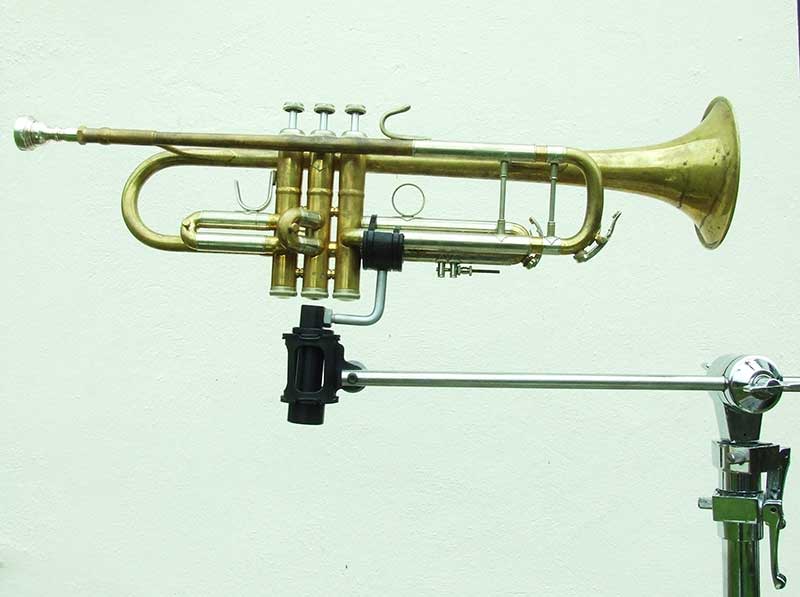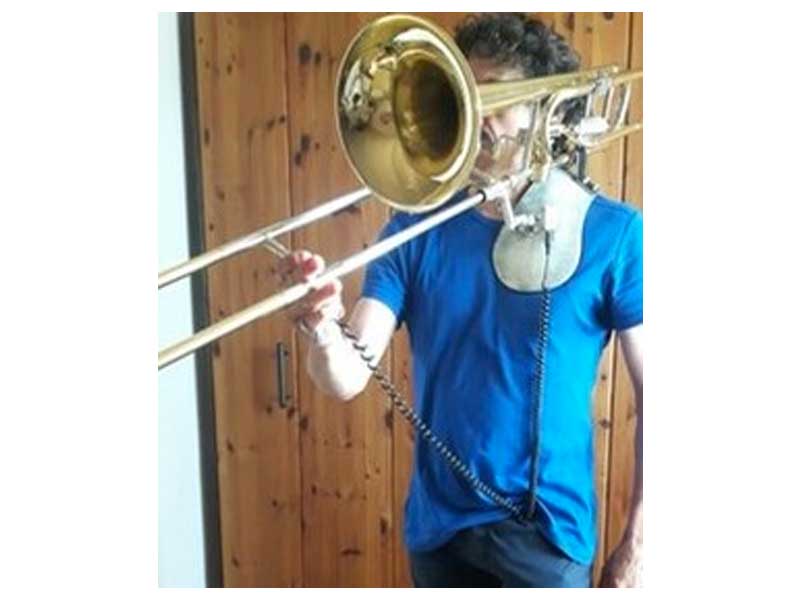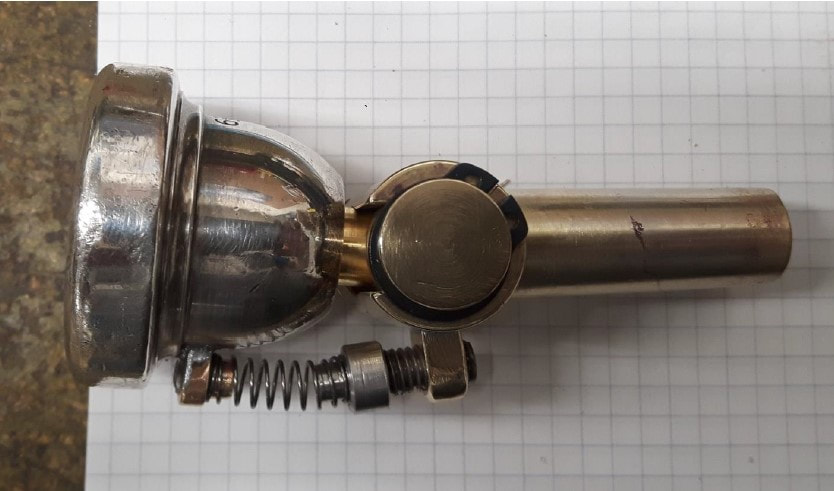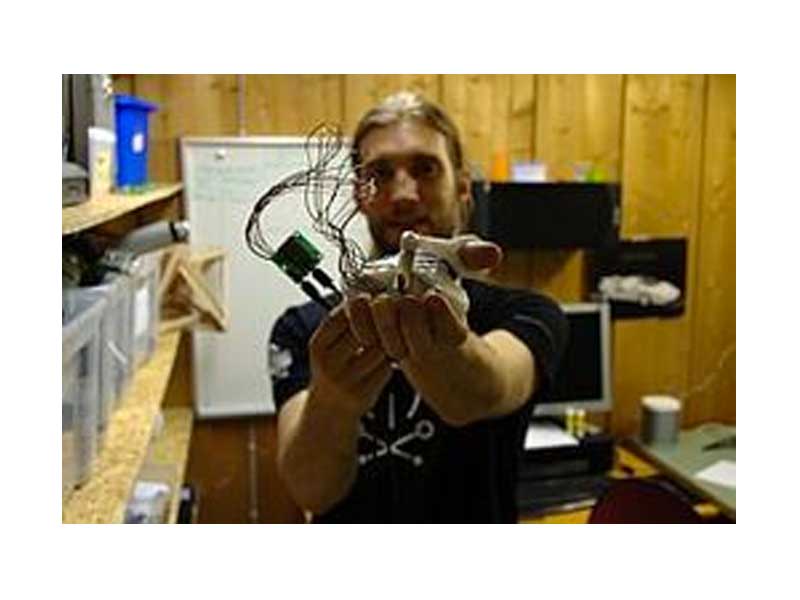Brass InstrumentsBrass instruments and enabling equipment made possible by the OHMI Competition or an OHMI commission.
|
Trumpet Stand
|
This is a very sturdy stand designed by Michael Prestage that will withstand the natural movement of the trumpet player but take the full weight of the instrument allowing a performer who does not have the use of one hand/arm to turn the page and not be overstrained by holding the instrument for a long time. The stand can be adjusted to any height and the flexible trumpet mount allows for a variety of playing postures.
|
Over Shoulder Trombone Mount
|
Thomas Tschirren’s system for playing the trombone with one hand uses an individually formed shell that is moulded to the player’s body from sternum around the shoulder to the spine. The instrument is connected to the shell by a short adjustable rod with a click system for easy mounting and dismounting. The trombone can be positioned to meet an individual’s preferences by loosening and tightening the screws on the rod, assuring that the playing position can be maintained even when the player is moving. The rear part of the trombone is guided by a piece on the shell formed out of an aluminium sheet. To protect the instrument, it is covered with felt. Additionally, one or more electric solenoid devices may be used to operate the valves on the instrument (if required). They are controlled by a switch attached to the player’s finger.
|
Pivoting Mouthpiece
|
This concept has been developed by Thomas Tschirren and is an attempt to solve the problem of pivoting a brass instrument when it is rigidly fixed on a support system or a floor stand. Most players find a slight pivoting motion is necessary when changing register from high to low and back. With floor stands and fixed mounts, this can be achieved to a certain degree with small movements of the head, neck and jaw. The pivot of the instrument changes the angle between the lips (and teeth) and the rim of the mouthpiece of 3-4°. The mouthpiece proposed here frees the player from a fixed position. Thomas’s idea is to create a joint between the cup and the shank of the mouthpiece.
|
The Trumpet Assist
|
This concept has been developed by Isaac Buckman and comprises a combination of eye-gaze software and mechanical adaptation of a three-valve trumpet. The software component uses a webcam to detect the gaze direction of the eyes. The seven possible valve combinations are mapped to different directions (up-left, up, up-right, and so on). The mechanical hardware component comprises a custom 3D-printed mount which allows 3 solenoid motors (linear actuators) to be placed directly over the keys of the trumpet.
The gaze detection software runs on an external laptop, and an Arduino microcontroller acts as an interface between the laptop and the solenoid circuitry. |
Trombone Floor Stand
|
The MERU Trombone Support Brackets are a range of small clips that may be fixed to a cymbal stand to hold different models of trombone steady for one-handed playing. Each clip is designed for one-handed mounting on to a standard trombone. Computer-aided design has produced a cheap and lightweight polymer bracket that fits around the main stay in the bell section of the instrument. The optional use of a simple safety lock then secures the instrument in the clip. The whole assembly may be put together or dismantled using only one hand. The latest iteration is available in the OHMI shop.
|
Euphonium/Tuba Floor Stand
|
The MERU adaptable Euphonium and Tuba playing stand is a lightweight, low cost instrument stand which can be adjusted to fit and support a range of different sized tubas and euphoniums. Instruments are supported by fully adjustable clamp brackets. The height, angle and position of different sizes and shapes of instrument can be set by sliding the supports into the desired position and tightening the bolts.
|
Trombone Harness
|
This modification was made by Michael Rath Trombones for Darren Walker. Darren has a neurological problem, affecting his back, lower legs and left arm. He is unable to support the weight of his trombone in a normal playing position for more than a couple of minutes.
The modification is in four parts, three of which attach to the trombone and a harness that attaches around the body, making it very robust. The parts are as follows: Part 1: A harness wrapping around the body and over the left shoulder. Parts 2 & 3: A flanged arm and handle attachment clipped to the harness and lower bell stay. Part 4: A handle comprising a curved metal base, which rests on the leg. |
The Foot/Knee Operated Chromatic Tuba Machine
|
This tuba was constructed by Ryan Baer after seeing a picture of a similar instrument from 1851! A tuba is placed in a stand and the valves are linked by cable to a piston mechanism which is operated by foot (and knee) instead of by hand. All other aspects of playing the tuba remain the same.
|
Synthobone
|
This concept is trying to emulate the trombone and was created by Petter Ericson and Thomas Hardin. Specifically, the instrument is a Teensy-based software synthesizer, where the input system consists of a ''slide'' operated by the thumb, and four buttons for the other fingers, used to choose the overtone. The concept uses the seven trombone positions so would be easy to understand for an existing trombonist and therefore practical to teach to others. The prototype is currently in it's infancy but has considerable potential to enable someone without the use of one hand/arm to be able to play an effective emulation of a trombone.
|
Foot Operated Trumpet Tuning Slides
|
Mechanical solutions to taking the weight of the instrument and operating the first and third valve tuning slides. Dave Woodhead has created a concept to operate the valve slides. A cable is attached to allow for operation via a foot pedal. A stand for taking the weight of the trumpet provides stability and grip. It is fully adjustable for both right and left handed players.
|
Donate to OHMIThere are so many disabled people who are desperate to play music with their peers. We can help to make that happen – but we can only do that with the wonderful support of our funders and donors.
As our instruments have to be hand-made by experts, they can only be produced in small numbers and are therefore expensive. Every little really does help.
|
Contact usIf you have a query or wish to contact us, please use the contact form available here.
You can also write to us: The OHMI Trust, 29 Woodbourne Road, Harborne, Birmingham B17 8BY |
Subscribe to our NewsletterIf you would like to join our mailing list and keep up to date with the latest news, please complete the form available here.
|
Privacy and Cookies Notice | Complaints Policy
All content © OHMI - Enabling Music-Making for Physically Disabled People
The OHMI Trust is a registered charity (Registered in England and Wales Charity No. 1143623, Scotland Charity No. SC052047).
Registered office: 29 Woodbourne Road, Harborne, Birmingham, B17 8BY
All content © OHMI - Enabling Music-Making for Physically Disabled People
The OHMI Trust is a registered charity (Registered in England and Wales Charity No. 1143623, Scotland Charity No. SC052047).
Registered office: 29 Woodbourne Road, Harborne, Birmingham, B17 8BY














